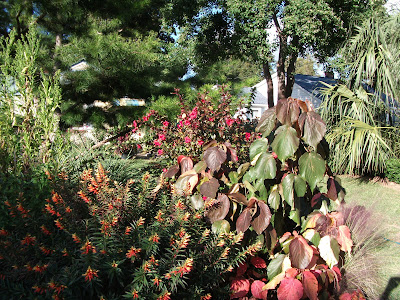The year of abundance, so much fruit that the trees are still full!A hot summer with regular rains must be citrus heaven. I`ve given bags away and still some of the trees are full, especially bad with the cold we been having.
The Kimbrough Satsuma has been picked, packaged for friends and eaten! The fruits were much bigger this year and extremely juicy but didn`t have the exceptional flavor of other years. I planted the the tree eight years ago and it has lived up to all the satsumas billing of a cold hardy delicious tree. She is grafted on a trifoliate root stock which adds to the cold tolerance and dwarfs the tree but she is no beauty. Satsuma have a lanky growth habit and send out long branches in any direction making them a sprawling plant.
The beauty of the dwarf citrus is the Nippon Orangequat! It grows as a tight mound spotted this time of year with hundreds of 2" bright orange fruit. I personally do not like the taste but many do. The fruit is eaten skin and all just like its kumquat ancestor. It will keep its fruit all winter dropping a few at a time until it blooms again in the spring. Early cold like this dries them but some will stay good all winter.
My poor Meiwa Kumquat would have needed another week to ripen, the cold has frozen them solid and they will dry out quickly now. It' like the orangequat and the satsuma is on a trifoliate root stock dwarfing the plant to a tiny 4'.
This year had a couple of firsts; my Changsha mandarin and Taiwanese lemon both fruited this year! The Changsha is a seedy Mandarin that bears small fruit five years after planting the seed.
The lemon is a year older and has so many fruits the branches are hanging at right angles to the main stem. It`s a sour seedy fruit but easy to grow and not likely ever to be hurt by my cold.
There is another citrus, the mystery tree that was supposed to be a sunquat(a type of lemonquat) but is gigantic. I purchased the seeds year ago from the now defunct Indoor Citrus Society from a reputable grower who must have also had a grapefruit in the yard. The tree and fruit are huge, the leaves look like grapefruit leaves but the plant is more cold tolerant. As to the fruit, they are as large as a grapefruit, yellow as a lemon and shaped like a pear. Delightfully smelling and tasting of both lemon and grapefruit but bland to the taste. The wind causes a little damage each year at the top but it always leafs back with almost no die back. A happy accident.
Playing November 23 – Winning For Fun
1 year ago






